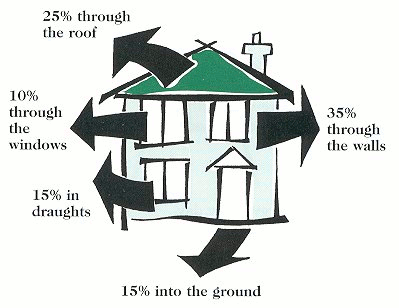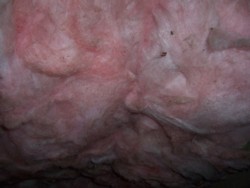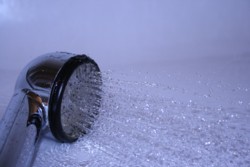Super Insulated Wall Systems
1 09 2011When most people are planning to build a new house they usually think about the number of rooms they will have, the layout and floor plan, maybe the type of heating system but rarely the insulation. Most people assume a new home built to code (whatever that jurisdiction the code is from) means that it must be well insulated and energy efficient.
While that may be true is some progressive jurisdiction, a lot of places the code barely mentions insulation, in any meaningful way at any rate. Or if it does it’s a minimum standard that falls well short of where insulation levels should be.
Insulation pays for itself, in most cases from day one as the increased cost to mortgage payments are more than offset by monthly energy bill savings. It’s rare that more insulation doesn’t help your bottom line in the short and long terms.
Some interesting ways to build conventional type houses with lots of insulation include:
Insulated concrete form insulation:
example: http://www.plastifab.com/news_events/images/thermal_insulation/adv_house.jpg
Insulated concrete forms (ICFs) are hollow blocks made of foam insulation that are stacked and filled with concrete. There are connection ties that hold the inside and outside foam together and rebar is installed to make the wall stronger. Average r-values are about R25 and this type of wall has a high thermal mass and is very airtight. Walls tend to be thicker than conventional construction and costs are significantly higher.
Double wall cavity insulation:
example: http://www.housing.yk.ca/pdf/SuperInsulatedWallSystemHandout.pdf
This type of wall uses a double framing system with a cavity that extends into the attic and is filled with loose fill insulation like cellulose or fibregalss. R-values range from R30-40 and the system is cheap and easy to build and insulate. It is a thick wall however and requires more square footage of the building than other systems.
Additional insulated strapwall:
example:http://oee.nrcan.gc.ca/residential/personal/home-improvement/images/interior-cut.gif
The addition of an extra strapwall on the inside of the exterior structural wall adds more insulation and allows the vapour barrier to be buried in the wall behind the plumbing and electrical reducing penetrations and increasing r-values and air tightness. Average R-value is about R22-24, costs are less than ICF and wall thickness is fairly high.
Extra layer of rigid insulation:
example: http://oee.nrcan.gc.ca/residential/personal/home-improvement/images/additions.gif
The addition of a layer of rigid foam (polystyrene, polyisocyanurate, etc…) adds an extra amount of r-value for very little extra thickness or costs. Air tightness is unchanged from conventional construction but the use of foil faced foams does add radiant reflection. R-value average from R22-26, thickness and costs are only marginally increased.
There are other methods (structural insulated panels, spray foam, natural building like strawbale, etc…) but the above are common methods that can be done by just about any contractor or homeowner/builder. If you are building new talk to your contractor or do some research on additional insulation techniques that will save you money and reduce energy consumption!
cross posted from http://greenspree.ca
http://greenspree.ca/post/8960467166/super-insulated-wall-systems
Categories : Alternative building, Energy Tip, Sustainability
 Heat rises. Such is the oft-quoted bit of wisdom used to justify preoccupation with attic insulation in houses and dismissal of the importance of basement insulation. This basic axiom is not entirely accurate however. Warm fluids (gases or liquids) will rise, this describes how heat moves via convection. Convection heat losses occur from leaks in a non airtight building envelope and in air exchanges through mechanical systems and envelope openings (door and windows). The proper use of air barriers and sealants eliminates or reduces this heat loss. This is not however the only manner of heat loss. Heat also moves via conduction and radiation.Conduction occurs when heat travels through solid matter, from an area of higher temperature to an area of lower temperature until a uniform temperature is achieved. This transfer of heat can happen in any direction, up or down, and always from hot to cold. This is the main source of heat loss in a foundation as the concrete foundation walls are in contact with the warm air inside the house and the cold ground outside the basement walls. The heat inside the house will want to travel tot he cold side of the foundation to achieve equilibrium, however the ground being an almost infinite thermal mass will continue to draw heat from the basement. The use of insulation, which is merely any material with a series of voids which breaks the thermal bridge used in conduction, stops or limits this transfer of heat.
Heat rises. Such is the oft-quoted bit of wisdom used to justify preoccupation with attic insulation in houses and dismissal of the importance of basement insulation. This basic axiom is not entirely accurate however. Warm fluids (gases or liquids) will rise, this describes how heat moves via convection. Convection heat losses occur from leaks in a non airtight building envelope and in air exchanges through mechanical systems and envelope openings (door and windows). The proper use of air barriers and sealants eliminates or reduces this heat loss. This is not however the only manner of heat loss. Heat also moves via conduction and radiation.Conduction occurs when heat travels through solid matter, from an area of higher temperature to an area of lower temperature until a uniform temperature is achieved. This transfer of heat can happen in any direction, up or down, and always from hot to cold. This is the main source of heat loss in a foundation as the concrete foundation walls are in contact with the warm air inside the house and the cold ground outside the basement walls. The heat inside the house will want to travel tot he cold side of the foundation to achieve equilibrium, however the ground being an almost infinite thermal mass will continue to draw heat from the basement. The use of insulation, which is merely any material with a series of voids which breaks the thermal bridge used in conduction, stops or limits this transfer of heat. Radiant heat losses occur when electromagnetic radiation is released from hot matter (the filament of light bulbs, element in electric heaters or combustion of fuel). This radiation travels in a straight line from it’s source and radiates out like light (which is a form of radiation as well). This radiation is absorbed at different rates by different forms of matter, it travels through air quite easily losing little of it’s intensity while our bodies would absorb more of it and reflective surfaces like foil or mirrors actually reflect and eliminate it’s loss. Normal insulation, being made up of high amounts of voids or air spaces perform poorly in stopping radiant heat losses while large thermal masses like masonry or solid wood absorb a lot of the radiant heat as it passes through it.
Radiant heat losses occur when electromagnetic radiation is released from hot matter (the filament of light bulbs, element in electric heaters or combustion of fuel). This radiation travels in a straight line from it’s source and radiates out like light (which is a form of radiation as well). This radiation is absorbed at different rates by different forms of matter, it travels through air quite easily losing little of it’s intensity while our bodies would absorb more of it and reflective surfaces like foil or mirrors actually reflect and eliminate it’s loss. Normal insulation, being made up of high amounts of voids or air spaces perform poorly in stopping radiant heat losses while large thermal masses like masonry or solid wood absorb a lot of the radiant heat as it passes through it. One of the things I hear a lot in my new position is that people want to build their new homes energy efficiently but think that they cannot afford to. Whenever I hear this I always say without hesitation “You can’t afford NOT to build you home energy efficiently!”. There are huge misconceptions out there about the costs, methods and effectiveness of building new homes efficiently. Most new home builders do not help the situation and will tell prospective customers that adding more insulation to their house, installing a geothermal or solar heating system or building to take advantage of passive solar gains will add an unreasonable amount of cost and time delay to the building process.
One of the things I hear a lot in my new position is that people want to build their new homes energy efficiently but think that they cannot afford to. Whenever I hear this I always say without hesitation “You can’t afford NOT to build you home energy efficiently!”. There are huge misconceptions out there about the costs, methods and effectiveness of building new homes efficiently. Most new home builders do not help the situation and will tell prospective customers that adding more insulation to their house, installing a geothermal or solar heating system or building to take advantage of passive solar gains will add an unreasonable amount of cost and time delay to the building process. Reducing your shower times by a mere 4 minutes, say from 15 to 11 minutes, will save a family of four heating with 11.5 cent KW/H electricity and using 2.5GPM shower heads $230 per year! These savings will only grow as the cost of energy continues to rise!
Reducing your shower times by a mere 4 minutes, say from 15 to 11 minutes, will save a family of four heating with 11.5 cent KW/H electricity and using 2.5GPM shower heads $230 per year! These savings will only grow as the cost of energy continues to rise!




